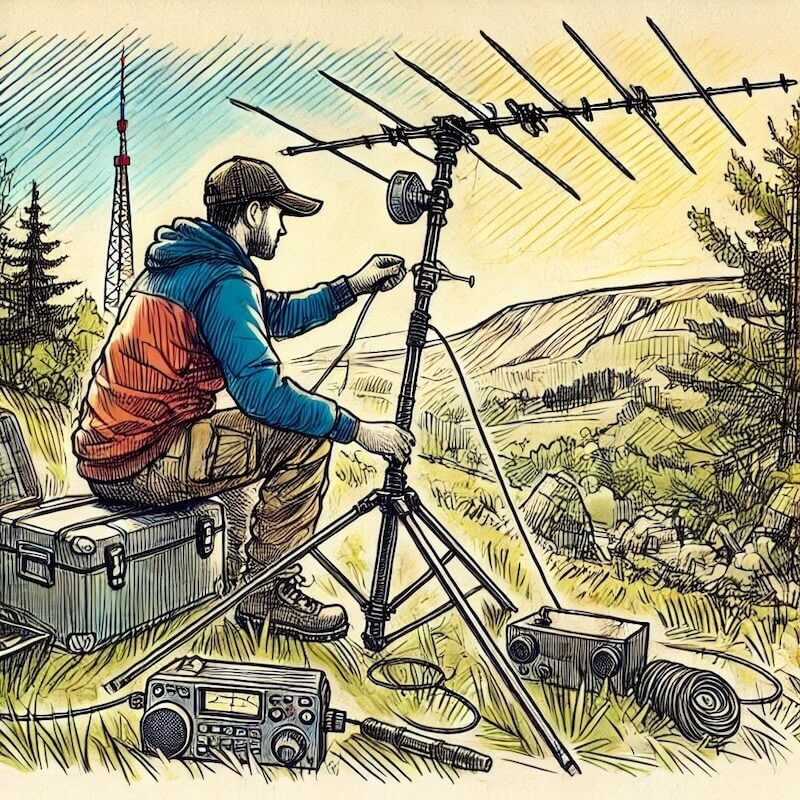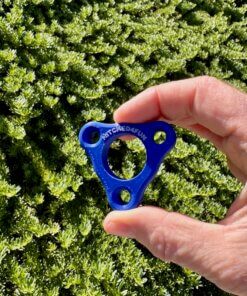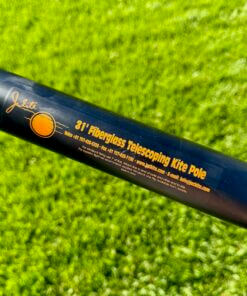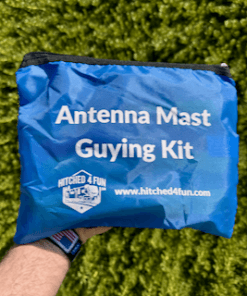If you’re an amateur radio enthusiast looking to elevate your setup, you need the right equipment to maximize your communication range and signal quality. One essential tool for any ham radio operator is the telescopic fiberglass antennas mast. With its lightweight construction and ability to extend to impressive heights, this type of mast allows you to optimize your antenna placement for clearer, more reliable signals. In this comprehensive guide, we’ll explore why an antennas mast is a must-have for amateur radio operators and how to make the most of it.
Why Every Amateur Radio Operator Needs a Telescopic Fiberglass Antennas Mast
A telescopic fiberglass antennas mast is an essential part of a ham radio operator’s toolkit because it provides versatility, portability, and durability. Unlike traditional metal masts, a fiberglass antennas mast is resistant to corrosion, making it suitable for outdoor use in various weather conditions. This feature alone makes it an excellent choice for emergency communications and field day events. They also don’t interfere with your signal transmission.
Moreover, the lightweight nature of fiberglass makes these masts easy to transport, set up, and adjust, making them perfect for temporary or portable stations. Whether you’re setting up in your backyard, at a campsite, or on a mountain, a telescopic antennas mast can help you reach distant contacts by elevating your antenna for optimal performance.
The Benefits of Using a Telescopic Fiberglass Antennas Mast for Amateur Radio
A telescopic fiberglass antennas mast offers several advantages over other types of masts:
- Portability: Due to their lightweight and telescopic nature, these masts can be collapsed for easy transport and storage.
- Durability: Fiberglass is resistant to rust and corrosion, making it ideal for outdoor use in all weather conditions.
- Adjustable Height: The telescopic design allows for customizable height adjustments, giving you control over the antenna’s elevation.
- Enhanced Signal Strength: Raising the antenna higher can significantly improve the line-of-sight for radio waves, resulting in clearer transmissions and better reception.
- Signal Transparency: Fiberglass does not interfere with radio signals, ensuring clearer and more reliable communication compared to metal masts.
How to Choose the Best Telescopic Fiberglass Antennas Mast for Your Ham Radio Setup
When selecting an antennas mast, there are several factors to consider:
- Height Requirements: Depending on the terrain and your communication goals, you may need a mast that extends to 30 feet or more.
- Weight and Portability: If you plan on using the mast in multiple locations, consider its weight and ease of transport.
- Durability: Ensure that the mast is made of high-quality fiberglass and features a rugged design suitable for outdoor conditions.
- Mounting Options: Look for masts that offer various mounting options, such as ground stakes, tripods, or bumper mounts, to fit your specific needs.
Maximizing Your Signal: Tips for Setting Up a Telescopic Fiberglass Antennas Mast
Setting up your antennas mast properly can make a big difference in your signal strength and communication range. Here are some tips to get the most out of your setup:
- Select the Right Location: Choose an open area with minimal obstructions to maximize your antenna’s line-of-sight.
- Adjust the Height Carefully: Higher isn’t always better. Experiment with different mast heights to find the optimal position for your specific frequency.
- Stabilize the Mast: Use guy wires or other stabilization methods to keep the mast steady, especially in windy conditions. See our Antenna Mast Guying Kit.
- Avoid Signal Interference: Keep the antenna away from large metal objects or other potential sources of signal interference.
-
Antenna Mast Guying Kit for Jackite 31-ft – Ham Ready
Original price was: $68.60.$45.95Current price is: $45.95.
DIY Portable Ham Radio Station: Setting Up Your Telescopic Fiberglass Antennas Mast
Building a portable ham radio station with a telescopic antennas mast can be an exciting DIY project. Here’s a step-by-step guide:
- Choose a Compact Radio Setup: Use a lightweight transceiver that’s easy to transport.
- Select a Portable Power Source: A battery pack or solar power can keep your station running while off-grid.
- Set Up the Antennas Mast: Extend the telescopic fiberglass mast to your desired height, and secure it with guy wires.
- Connect the Antenna and Radio: Ensure all connections are tight, and the antenna is properly tuned for the frequency you intend to use.
- Test Your Setup: Make a few test transmissions to verify the performance.
The Role of a Telescopic Fiberglass Antennas Mast in Emergency Communications
When disaster strikes, amateur radio operators often play a crucial role in providing emergency communications. A telescopic fiberglass antennas mast is an invaluable tool in such situations due to its portability and quick setup. Here’s why it’s perfect for emergency communication:
- Rapid Deployment: The telescopic design allows for a quick setup, which is essential during emergencies.
- Reliable Communication: Raising the antenna with a mast improves signal clarity and range, even in remote locations.
- Durability Under Stress: Fiberglass construction ensures that the mast remains functional in harsh weather conditions, providing a dependable communication link.
Maintenance Tips for Extending the Life of Your Telescopic Fiberglass Antennas Mast
Taking care of your antennas mast ensures it will last for years. Here are some maintenance tips:
- Regular Cleaning: Wipe down the mast to remove dirt, salt, and other debris that could cause wear.
- Inspect for Damage: Regularly check for cracks or signs of wear, especially around the joints.
- Lubricate Joints: Apply a light lubricant to the mast joints to keep the telescoping sections moving smoothly.
- Store Properly: When not in use, collapse the mast and store it in a dry place to prevent any damage.
Telescopic Fiberglass Antennas Masts vs. Aluminum Masts: Which is Better for Ham Radio?
While both fiberglass and aluminum masts have their benefits, the telescopic fiberglass antennas mast offers unique advantages:
- Lightweight: Easier to carry and set up than aluminum masts, making it suitable for portable and emergency applications.
- Corrosion Resistance: Unlike aluminum, fiberglass won’t rust, making it more durable in damp environments.
- Flexibility: Fiberglass can flex without breaking, which can be beneficial in windy conditions.
- Minimized Interference: Fiberglass does not conduct electricity or reflect radio waves like aluminum does, preventing signal distortion and ensuring more consistent signal propagation for clearer communication.
Get Your Telescopic Fiberglass Antennas Mast Now!
Don’t wait until the last minute to upgrade your ham radio setup! Our telescopic fiberglass antennas masts are in high demand due to their quality and versatility. With limited stock available, now is the perfect time to secure your mast and be prepared for any situation. Don’t miss out on enhancing your communication range—order today and experience the difference.
Conclusion
A telescopic fiberglass antennas mast is a valuable asset for any amateur radio operator. Its portability, durability, and versatility make it ideal for various applications, from field day events and emergency communications to setting up a portable ham radio station. By understanding the benefits and proper usage of this essential equipment, you can maximize your radio setup’s performance and reliability.
Visit Hitched4fun.com today to browse our selection of high-quality telescopic fiberglass antennas masts and other essential ham radio accessories. As America’s #1 RV Supply Store, we’re here to help you stay connected, wherever your adventures take you.
FAQs
- What is the advantage of using a telescopic fiberglass antennas mast over a metal mast?
- Fiberglass masts are lightweight, resistant to corrosion, and can flex without breaking, making them ideal for outdoor use and portable setups.
- How tall should my antennas mast be for optimal signal strength?
- The ideal height depends on the terrain and frequency used. Experimenting with different heights can help find the optimal position for the best signal.
- How do I stabilize my telescopic fiberglass antennas mast?
- Use guy wires, tripod mounts, or bumper mounts to secure the mast and prevent it from tipping over in windy conditions.
- Can I use a telescopic fiberglass antennas mast for emergency communications?
- Yes, it’s perfect for emergency communications because of its quick setup and ability to enhance signal clarity and range.
- What maintenance does a telescopic fiberglass antennas mast require?
- Regular cleaning, inspection for damage, lubrication of joints, and proper storage can help extend the life of your mast.
#hitched4fun #HamRadio #AmateurRadio #AntennasMast #EmergencyCommunications #PortableHamStation #FieldDay #HamRadioEssentials #TelescopicMast #RadioOperator #Preparedness #DIYHamRadio #OutdoorRadio #AntennaSetup #PortableAntenna




